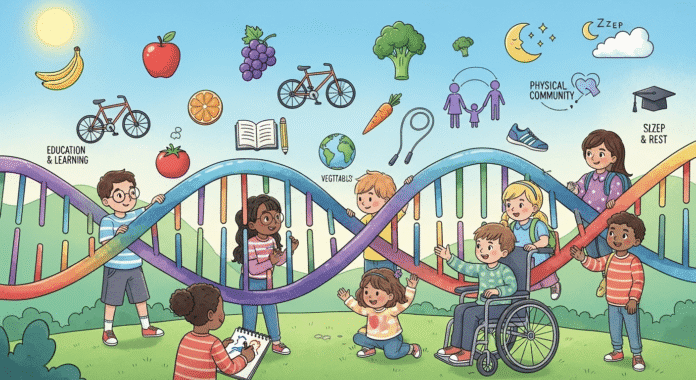A new genetic tool claims to spot kids at risk for obesity—how reliable is it, and what should parents know?
The idea that a simple test could forecast whether a child will become obese as an adult may seem like science fiction. However, a cutting-edge genetic tool is now attracting attention for its promise to identify children at risk. This tool uses a polygenic risk score (PRS), analyzing thousands of genetic markers to provide an early warning system. In this article, we explore the science behind the tool, its accuracy rates, and what it truly means for our children, parents, and society at large.
The Science Behind the New Obesity Prediction Tool
How Does It Work?
The genetic tool operates on the concept of a polygenic risk score. By examining thousands of small genetic variations, the test calculates a score that estimates a child’s predisposition to obesity. Unlike traditional methods that focused only on family history or a few genes, this advanced system leverages data gleaned from over five million people. The tool prioritizes markers linked to appetite regulation, metabolism, and overall energy balance. Studies published in scientific journals have shown that this approach can explain nearly 20% of the variation in body mass index (BMI) among individuals.
The test is not intended as a definitive prediction but rather as a guide for early intervention. Its predictive capacity has proven robust, particularly among children of European ancestry. For instance, research indicates that the tool can achieve an accuracy rate—with an area under the curve (AUC)—of about 81.7% for girls and 76.1% for boys when forecasting obesity by age five.
What Sets This Tool Apart?
A major breakthrough in this new method is its ability to integrate an enormous volume of genetic data into a single, actionable risk score. Earlier techniques often yielded limited insights because they did not capture the complexity behind obesity, a condition influenced by both genetic and environmental factors. However, this new tool has enhanced predictive power. As Professor Ruth Loos from the University of Copenhagen put it, “This is a dramatic improvement in predictive power. It brings us closer to offering clinicians a helpful tool, though genetics is only part of the story.”
Despite these advances, the tool’s accuracy is not uniform across all groups. For children of African ancestry, for example, the prediction rate is lower—a limitation that highlights the necessity for more inclusive genetic datasets. The scientific community acknowledges that while the technology is promising, further research is needed to ensure it works equitably for every child.
What Does This Mean for Parents and Children?
Empowering Early Interventions
For parents, the promise of early detection cannot be understated. The ability to identify a high-risk profile before obesity sets in means that families can adjust lifestyle choices at an early stage. Practical steps might include adopting healthier eating habits, increasing physical activity, and scheduling regular medical checkups. Early intervention is seen as essential for preventing long-term complications such as diabetes or heart disease.
The tool also offers a degree of empowerment. Armed with genetic insight, parents can tailor everyday decisions—from nutritious meals to regular outdoor play—making them less uncertain about the root causes of weight gain. In this way, the test serves as an early warning system rather than a definitive judgment, enabling proactive measures that could significantly alter a child’s health trajectory.
Balancing Information with Emotional Well-being
There is a fine balance between empowerment and anxiety. While some parents may feel relieved to have concrete data, others might experience stress or guilt after learning about an elevated risk. Equally, children who are labeled “at risk” may be more susceptible to anxiety or a negative self-image if this information is mishandled.
Dr. Connie Lewis, a pediatric ethicist, emphasizes the importance of maintaining a supportive environment. “Genetic risk scores should guide, not define, a child’s future,” she states. The information must be used to encourage healthy practices rather than becoming a label that limits a child’s opportunities. Parents and educators alike need to approach the results with sensitivity, ensuring that the focus remains on holistic well-being.
Avoiding the Pitfall of Stigmatization
One of the biggest concerns is the risk of stigmatization. When children are flagged as being at risk for obesity, they may face bullying, discrimination, or even lower expectations from educators and peers. This risk is especially pronounced in environments such as schools or organized sports, where physical appearance can influence social interactions.
The solution lies in careful communication and policy. Families should be advised on how to discuss the results in a way that emphasizes proactive health rather than inevitable failure. Medical professionals and schools must coordinate to provide counseling and other supportive measures to ensure that the information empowers rather than isolates.
The Bigger Picture—Ethics, Equity, and Public Policy
Protecting Privacy and Data Security
Genetic data is inherently personal. As with any sensitive information, there is a risk that it could be misused—whether by insurers, employers, or other third parties. For this reason, robust data privacy laws and strict security measures are essential. Legal frameworks must ensure that any collected genetic data remains confidential and is used solely for the benefit of the child’s health.
Ensuring Equity and Accessibility
While the science is promising, the benefits of genetic testing must be accessible to all families. Currently, access to such advanced testing tends to be concentrated among wealthier segments of the population. This unequal access could contribute to widening health disparities. Public health policy must address these inequities by subsidizing testing and ensuring that the benefits of early intervention are not limited to a privileged few.
Integrating Genetics with Environmental Factors
The full picture of childhood obesity is complex. Critics worry that an overemphasis on genetics might divert attention from critical environmental factors such as food deserts, aggressive marketing of unhealthy foods, and the lack of safe spaces for play. A holistic approach considers the interplay of genetic predisposition and lifestyle factors. The consensus among public health professionals is that policy measures and community programs must continue to tackle environmental contributors while genetic tools enhance early detection.
Counterarguments and Concerns
Is the Science Ready for Prime Time?
Not every expert is convinced that the current state of genetic prediction is entirely reliable. Some pediatricians caution that while the tool shows promise, the inherent complexity of obesity means that genetic indicators may not capture every risk factor. There is also the possibility of false positives or negatives, which could lead to either unwarranted anxiety or a false sense of security.
The Risk of Fatalism
A further concern is the potential for a self-fulfilling prophecy. If parents or children believe that obesity is inevitable due to genetics, they may be less likely to engage in healthy behaviors. In such cases, the information could inadvertently lead to poor health outcomes rather than prevent them. It is crucial that genetic insights are delivered with the understanding that lifestyle choices and environmental influences play a significant role in determining health.
Impact on Public Health Policy
From a policy perspective, concerns have been raised that significant funds and attention directed toward genetic testing could detract from community-based interventions that have proven effective. Experts argue that resources should continue to be allocated to nutrition education, accessible recreational facilities, and public health campaigns that target the broader determinants of obesity.
What Should Parents and Policymakers Do?
For Parents
Parents can take meaningful steps using the genetic information as a useful guide rather than a conclusive diagnosis. It is essential to focus on nurturing healthy lifestyle habits, such as balanced diets, regular physical activity, and stress management. Parents should work closely with healthcare providers to develop individualized health plans that incorporate both genetic insights and environmental factors. Moreover, it is vital to foster an environment that encourages healthy behaviors and emotional resilience, ensuring that the child does not feel defined by their risk score.
For Policymakers
Policymakers have an important role to play in ensuring that scientific advances lead to equitable health outcomes. Ensuring that genetic testing is accessible and affordable for every family is a key priority. Laws and regulations should protect personal genetic data from misuse and guarantee that the benefits of such tools are shared across communities. Additionally, investments in community infrastructure—like nutrition education programs and safe recreational areas—should continue to address the environmental aspects contributing to childhood obesity.
By balancing innovation with community-centered interventions, society can transform this genetic breakthrough into a powerful tool for public health without exacerbating existing disparities.
A Tool, Not a Crystal Ball
The arrival of a genetic tool to predict childhood obesity represents a significant scientific advance. By offering early clues about a child’s risk, the tool provides an opportunity for timely, personalized intervention. However, its use demands a balanced approach that considers the limitations of genetic prediction and the overwhelming influence of environmental factors.
Families and policymakers alike must work together to ensure that this technology serves as an empowering guide rather than a stigmatizing label. Integrating genetic insights with robust support systems and community resources will be crucial in fostering healthier futures for all children. It is not the genes alone but the action taken afterwards that will define a child’s journey toward a healthier life.
The conversation does not end here. It is a call to action for continued research, community engagement, and thoughtful public policy. Parents should discuss genetic results with healthcare professionals to chart informed paths, and policymakers must build systems that protect privacy, promote equity, and address both genetic and environmental dimensions of childhood obesity.
“We’re closer than ever to understanding the roots of obesity,” reflects Professor Loos. “But the real solution will always be a mix of science, compassion, and community.”



